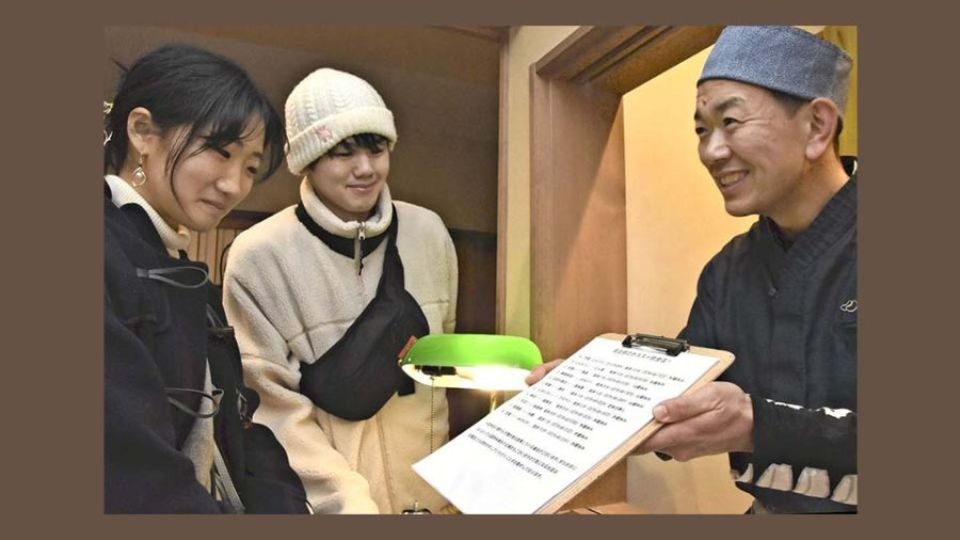February 20, 2025
MAEBASHI/NIIGATA – More ryokan Japanese-style inns in hot spring resorts nationwide are no longer offering dinner for their overnight guests and are encouraging them to eat at nearby restaurants.
While ryokan traditionally offer two meals for each night’s stay, overnight stays without meals have become more common as a result of foreign tourists wanting to explore different kinds of Japanese food, as well as staffing shortage. Under such circumstances, it is crucial for ryokan, restaurants and other facilities to collaborate with each other to attract tourists to their towns.
At the Kusatsu onsen hot spring resort in Gunma Prefecture, Yoshihisa Mizuide, 45, who runs the ryokan Omame no Koyado Hanaingen, showed guests a list of restaurants he recommends.
“I’m looking forward to trying new places,” said a university student, who was staying at the ryokan with her friend.
More ryokan in Kusatsu have stopped offering dinner and only offer breakfast or no meals at all. While only a handful of such ryokan existed 20 years ago, now, about 30 of the approximately 110 facilities belonging to the local ryokan cooperative offer such plans.
The Omame no Koyado Hanaingen only offers breakfast. He reopened the ryokan in 2016, which had been run by his grandparents, thinking that he could run the inn with his mother if they did not serve dinner.
The Naraya Group operates six ryokan in Kusatsu, four of which offer overnight plans without meals. The number of employees needed to operate a ryokan that does not serve dinner is about one-fifth the number needed to operate a ryokan of the same size that does.
“This system allows us to increase room occupancy rates and gain more profit,” said Tatsuya Saeki, 49, who is involved in the management of the group.
Since overnight guests go out to eat, the number of restaurants belonging to the town’s restaurants’ association increased to nearly 120, a 20% rise compared to pre-pandemic levels.
As overnight plans without meals have become more common, the number of tourists to the town reached a record 3.7 million in fiscal 2023. The number is expected to exceed that figure in fiscal 2024.
“We now have a virtuous cycle in which both ryokan and restaurants benefit,” said Kusatsu Mayor Nobutada Kuroiwa.
Lack of staff
The shortage of personnel is one of the reasons behind more ryokan offering overnight plans without meals. The number of employees declined during the COVID-19 pandemic, but now that the pandemic has passed and tourist numbers has surged, personnel shortages have become a serious problem.
According to a Teikoku Databank Ltd. survey conducted in October 2024, while the personnel shortage issue has been resolved to a certain extent, about 60% of ryokan and hotels cited they did not have enough regular and nonregular employees.
According to a survey by the Japan Tourism Agency in 2023, the average occupancy rate for ryokan was less than 40%, significantly lower compared to city hotels and business hotels, which had an average occupancy rate of about 70%.
“We’re having a difficult time hiring new employees, so we’re not able to open all the guest rooms due to a shortage of kitchen and serving staff,” said Takamichi Otonari, who runs the Oku no Yu ryokan in the Kurokawa hot spring resort in Aso, Kumamoto Prefecture.
The Japan Ryokan & Hotel Association said that some ryokan and hotels are closed on certain days because they lack staff.
If ryokan stop offering dinner and only focus on services regarding stays, the average amount customers pay would decline. However, the switch would allow them to accept more guests with fewer employees, resulting in increased room occupancy rates. Profits would also increase because personnel and other costs can be reduced.
The increasing number of foreign tourists who tend to not spend as much on accommodations and spend more at restaurants gave the trend a boost. A 2017 survey by the Japan Tourism Agency on hot spring resorts and other tourist areas found that 40% of areas that catered to foreign tourists had ryokan and other accommodation facilities that did not serve meals.
Involving entire community
In order to accept guests who do not eat at the ryokan, some areas are working to create a system in which guests can eat and drink in the hot spring town.
At the Kinosaki hot spring resort in Hyogo Prefecture, restaurants stayed open later for overnight guests to have dinner.
The Matsunoyama hot spring resort in Niigata Prefecture built a facility where a cafe, a bar and a tourist information center are close together to make it easier for long-term guests.
The Yuzawa Night Marche event was held last winter in Yuzawa, Niigata Prefecture, which is generally crowded with skiers. Cars were prevented from entering a shopping street on certain days for the event, and about 30 food trucks lined the street. The event was planned by a local group and others.
Since most tourists only visit during winter, there are only a few restaurants in the town. As more accommodation facilities stopped serving dinner due to aging owners and a shortage of staff, overnight guests had difficulty finding a place to eat.
“The number of ryokan offering overnight plans without meals will further increase given the labor shortage and the increasing number of foreign tourists,” said Takao Ikado, professor of tourism studies at Kokugakuin University. “If guests find it difficult to find places to eat in a hot spring town, the entire town will lose its ability to attract tourists. It’s important to take measures that involve the entire community.”

